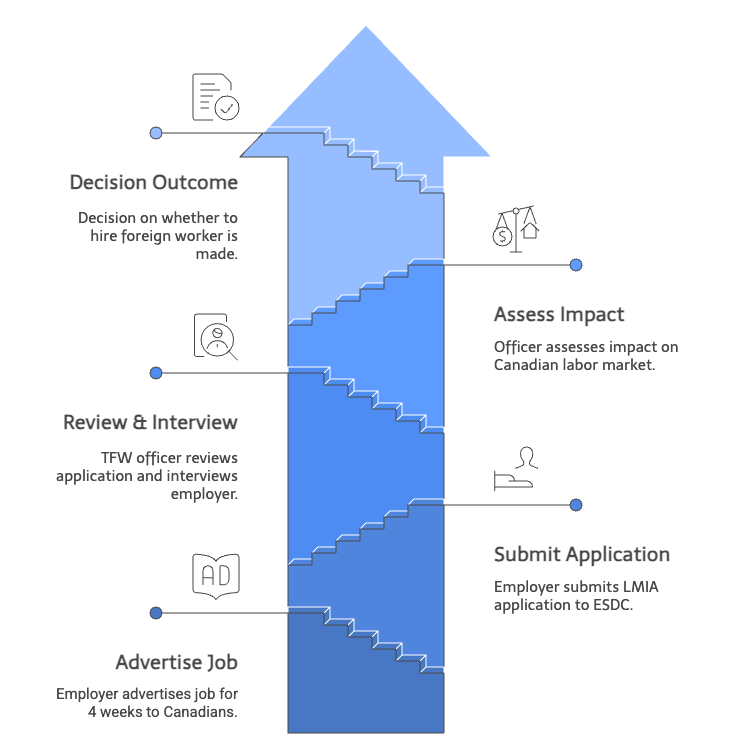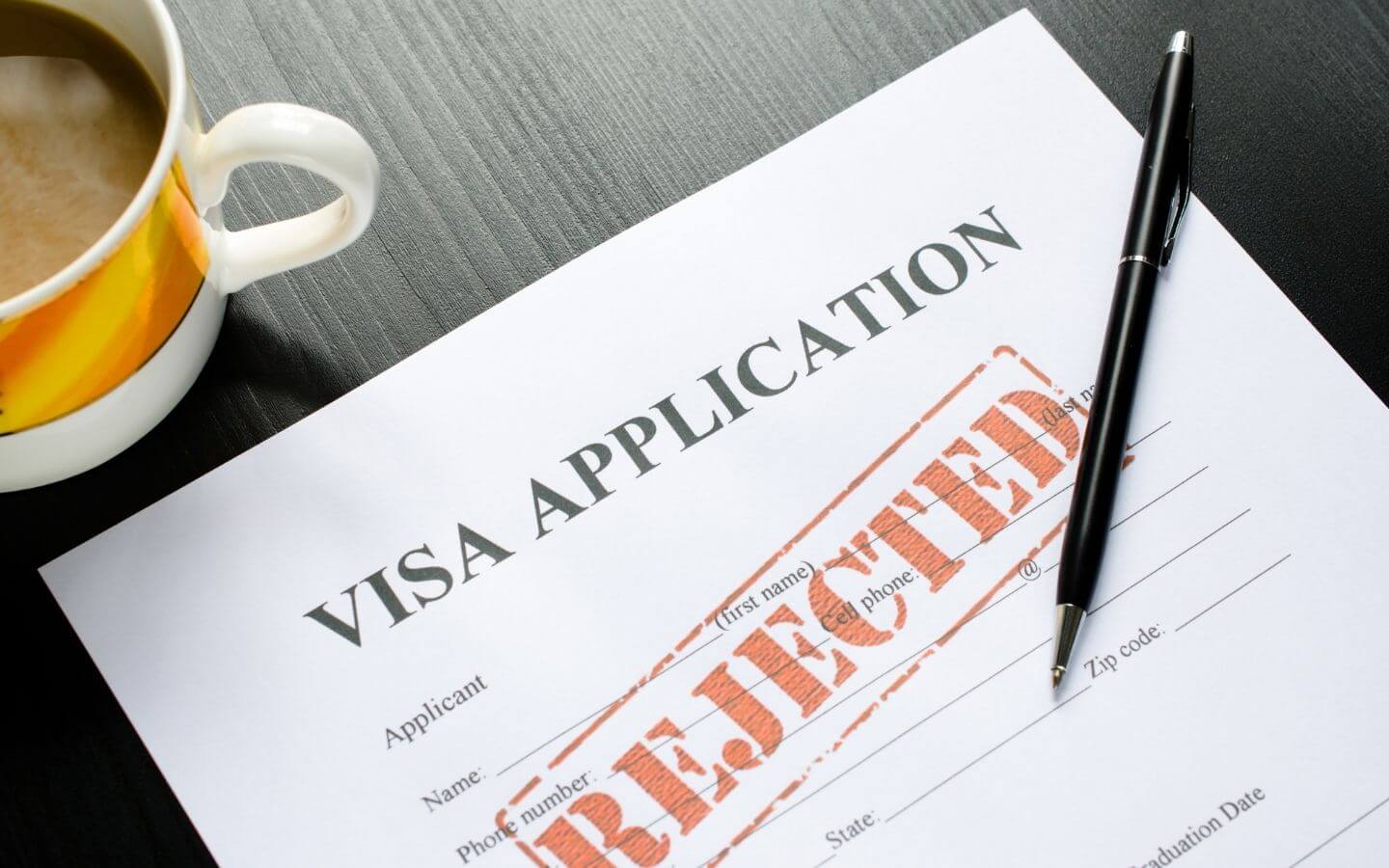Preparing an LMIA application is a complex process. Before you can apply, you must take several preliminary steps. This comprehensive guide walks you through every stage of the LMIA application process, from initial position assessment to receiving your decision and applying for a work permit.
Step 1: Determine LMIA Type Needed
To determine the LMIA type needed, you must first conduct a position assessment. This involves confirming the National Occupational Classification (NOC) system code for the position and the minimum wage required to be offered.
Wage Determination
The wage must usually be at or above the median wage for the occupation in the intended region of employment. It must also meet or exceed the wages offered to existing employees in that occupation in your business at a similar level. The higher of these must be the offered wage.
However, sometimes specific wage rules apply, such as for fee-for-service physicians or unionized employees. It is important to follow the specific wage variations as well to ensure application success. You may need to hire a lawyer to assist you identify the right NOC, wage requirements and variations.
Business Legitimacy and Financial Capacity
Next, after determining the occupation, wage and stream, you must determine whether your business qualifies by reviewing the business legitimacy and financial capacity requirements of the stream.
Only legal businesses that are actively and regularly doing business in Canada — i.e., selling goods or services on an ongoing basis — and who have sufficient financial resources and legitimate business needs qualify. A lawyer familiar with the LMIA assessment process can review your business’s financial and legal documentation to ensure you meet the requirements.
Verify Foreign Worker Qualifications
Then, you should verify that the foreign national you wish to hire has the qualifications for the position. Reviewing documentation from foreign nationals can be tricky, as proof of language ability, education and work experience varies from country to country.
A Canadian immigration lawyer who has a wide variety of experiences with clients from around the world, and is sensitive to local differences in culture and customs, is often needed to ensure an appropriate match between Canadian and international standards. In some cases, formal language and education assessments may be required.
Review Advertising Requirements
Now that you have assessed the position, verified business legitimacy and financial capacity, and confirmed the foreign national’s qualifications match Canadian standards, you can now review the stream requirements to see if an advertising and recruitment campaign is required.
If it is, advertisements must generally be national in scope, target Canadian citizens and permanent residents across multiple platforms and sources, and may need to target underrepresented groups. An ad must also be placed on the Job Bank website.
Sometimes, variations to advertising requirements exist, so it is important to review those variations before proceeding. Most advertising campaigns must persist for a minimum of 4 weeks, while at least one national in scope ad must usually persist throughout LMIA application processing until a decision is made.
Related: Complete LMIA requirements and documents checklist →
Before proceeding with recruitment efforts, it’s crucial to confirm you’re applying under the correct LMIA stream. Each stream has distinct requirements that will affect your entire application strategy:
LMIA Stream Comparison Guide
Choose the right stream for your position
High-Wage LMIA
Professional & management positions
Low-Wage LMIA
Entry-level & support positions
Global Talent Stream
Tech, innovation, high-skilled
SAWP
Seasonal agricultural work
Quick Decision Guide
- ✓ Wage is 20%+ above provincial median
- ✓ Professional/management position
- ✓ Need 2-3 year duration
- ✓ Wage below high-wage cutoff
- ✓ Entry-level or support position
- ✓ Can meet 10% workforce cap
- ✓ Tech/innovation company
- ✓ Need fast processing (10 days)
- ✓ Can negotiate LMBP commitments
- ✓ Primary agriculture sector
- ✓ Seasonal work (max 8 months)
- ✓ Hiring from participating countries
Step 2: Complete Recruitment Efforts
Job Bank Candidate Matching
Employers must ensure they are also inviting candidates to apply who have been matched on the Job Bank service. Matches are rated by “star”, with one star representing a low match, increasing up to five stars for a very high match.
The different streams have different rules for matching, so it is important to pay attention to which rated candidates you will need to invite:
- High-wage stream: Invite all candidates ranked 4 stars or higher
- Low-wage stream: Invite all candidates ranked 2 stars or higher
Invitations must be sent beyond the minimum 4-week advertising period, right through to the conclusion of LMIA application processing. Throughout the 4 or more weeks of advertising, employers are required to review all applications from Canadian citizens or permanent residents.
Interview Requirements
Employers must invite to an interview any job applicant who is a Canadian citizen or permanent resident and who meets the advertised requirements of the position.
Employers must not discriminate on the basis of nationality or immigration status, either, as these could raise a human rights issue. Balancing these requirements – to consider Canadians first while not discriminating on the basis of nationality or immigration status – requires expert knowledge at the intersection of immigration law, employment law and human rights law.
Only a lawyer is professionally qualified to advise you on how to properly balance these considerations and represent you in an application for an LMIA.
Documentation Requirements
Employers must thoroughly document advertisements, recruitment efforts and interviews. Those records will likely be requested and reviewed by a TFW program officer.
While you may mean well by using language in your records that is meant to convey a legitimate effort to hire Canadians first, preferential language can be seen as a sign that your workplace is discriminatory and can be used as a ground to refuse the LMIA.
Therefore, before you prepare your list of questions for job candidates and make verbal and written records of your communications, you should consult with a lawyer on the dos and don’ts of LMIA application candidate screening.
Making the Conditional Job Offer
If after these extensive efforts you were unable to find a suitably qualified Canadian citizen or permanent resident for the position, you may make a conditional offer of employment to the foreign national – conditional, of course, on approval of a LMIA and work permit.
Step 3: Prepare Required Documents
Now that you have completed the preliminary steps, it is time to prepare and assemble all the required documents and prepare the LMIA application.
Required Forms and Contracts
You must complete all required forms and ensure your contracts — including employment contracts/job offers and services or purchase agreements — are legal and compliant with relevant immigration, employment and business laws.
Document Assembly
You must assemble your NOC assessment records (and re-check that there have been no changes to the wages or stream requirements), business legitimacy and financial capacity documents, and advertising and recruitment campaign records.
All of this must then be submitted via a secure online portal to the TFW program.
Transition Plan or Labour Market Benefits Plan
High-wage stream applications require a detailed transition plan. Global Talent Stream applications require a Labour Market Benefits Plan (LMBP). These must be completed in standard form and demonstrate your commitment to supporting Canada’s labour market.
Pro tip: Don’t forget to keep your Job Bank or other national-in-scope advertisement running! If it lapses at any time during processing, your application may be refused.
Related guides:
Step 4: Submit Your LMIA Application
Once all documents are prepared and organized, you can submit your LMIA application through the secure online portal to the Temporary Foreign Worker Program.
Ensure that:
- All required forms are complete
- All supporting documents are included
- Your national-scope advertisement remains active
- You have copies of everything submitted
Step 5: Wait for Processing
The processing time for every LMIA application depends on the particular stream you have applied for, the number of applications in the inventory, whether your employer has received a prior, recent approval for an LMIA, and whether your application is eligible for priority processing.
Processing Time Factors
If you did not include all required documents in your application for an LMIA, your application processing times may be longer than the processing times listed, or it can be rejected as incomplete.
Processing times generally range from:
- 10 business days or less: Global Talent Stream and critical occupations
- 4-12 weeks: Moderate priority occupations
- 8-20+ weeks: Lower priority or frequently requested occupations
The TFW Officer Interview
Your business’s main representative will be contacted to schedule a review of your application with a TFW program officer. Foreign workers cannot attend these meetings. Only designated employees of the business or appointed representatives, such as lawyers, may attend the interview.
Interviews are typically conducted virtually by Microsoft Teams or by phone.
What the Interview Covers
All aspects of the LMIA application can be examined in the interview. This means the business must be prepared to answer questions from the TFW officer relating to:
- The position offered
- The applicants for the position
- The advertisement and recruitment campaign
- The business’s need to fill the position
- The business’s activities in Canada
- The financial capacity of the business to pay the wages to the worker
- Other elements of the application relating to the business’s hiring of the foreign worker
Verification of Business Information
Furthermore, TFW program officers may verify business information by examining federal business records available from Industry Canada, Canada Revenue Agency or Service Canada. They may also search for information online.
Any discrepancies or inconsistencies in the answers provided by the business in the interview, information publicly available online or information contained in official government records, with information contained in the application can lead to processing delays or an application refusal.
Step 6: Receive Decision
The TFW program officer may request additional documents or information to clarify the details of the application. This is fairly routine for businesses that are new to the TFW program and should not on its own be seen as a cause for concern.
Pre-Refusal Notifications
However, if a TFW officer believes that your business may not be eligible, or the application suffers from some other deficiency, they may communicate this concern verbally or in writing before making a final decision.
Not all concerns are communicated in advance, and some officers may refuse the application if they believe they have sufficient information and documentation upon which to base their decision.
Approval Criteria
If a TFW program officer is satisfied that your application is complete, that the position offered is genuine, that your company can pay the wages offered, and that you have demonstrated a neutral or positive labour market impact (i.e., you have demonstrated a genuine labour shortage), then your LMIA application may be approved.
Approval decisions are communicated in writing, either through email or through the LMIA online application portal.
Related: Why was my LMIA refused? Common rejection reasons →
Step 7: Worker Applies for Work Permit (If Approved)
Following the approval of an LMIA, the foreign worker may apply for a work permit. An application must be made before the LMIA expires.
Where to Apply
Applications for work permit may be made:
- Online inside of Canada
- Online outside of Canada (which proceeds to an overseas visa office)
- At a port of entry into Canada
The rules regarding where you may apply vary by nationality/passport of the applicant, status of the applicant, occupation and other factors.
It is important to consult with a Canadian LMIA and work permit lawyer to determine the available options. A Canadian work permit lawyer can assist you with determining the methods available, which method may give you the best chance at approval, and which method may result in the fastest processing.
If the Work Permit is Refused
A work permit application that is deficient in some respects can be refused. If the LMIA is still valid and has not yet expired, the worker may re-apply.
If the LMIA has expired and is no longer valid, the worker should discuss with a work permit appeals lawyer what options may be available to appeal the decision.
How Mandelbaum Immigration Lawyers Can Help with Your LMIA Application
The LMIA application process involves multiple complex steps, each representing a potential refusal point. Our experienced immigration lawyers provide comprehensive support throughout the entire process:
Position assessment
We help you correctly identify the NOC code and determine the appropriate wage level and stream.
Business qualification review
We assess your business legitimacy and financial capacity before you begin, saving you time if there are issues to address.
Advertising campaign design
We create compliant advertising strategies that meet or exceed program requirements.
Recruitment documentation
We help you properly document your recruitment efforts in a way that demonstrates genuine effort while avoiding discriminatory language.
Application preparation
We prepare complete, organized application packages that TFW officers can process efficiently.
Interview preparation
We prepare you for TFW officer interviews and can attend as your legal representative.
Response to concerns
If officers raise concerns during processing, we help you respond effectively to address their issues.
Don’t navigate the complex LMIA process alone. A single mistake can mean months of delay and starting over. Contact our law firm today to schedule a consultation.
Mandelbaum Immigration Lawyers can guide you through every step of the LMIA application process. Simply provide us with your name, email address and phone number by filling out our webform, emailing us at info@dmandelbaum.com, or calling our office during business hours.





